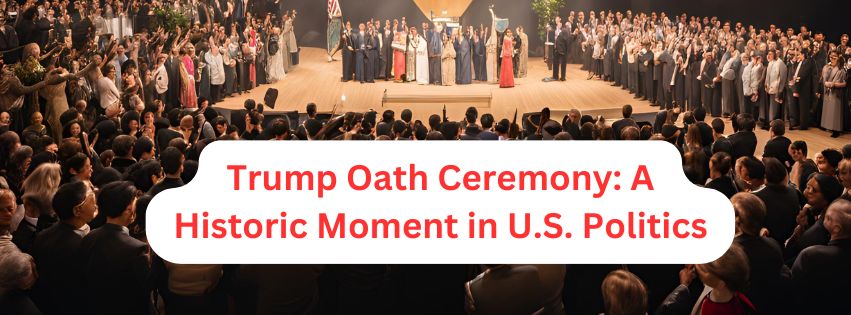Trump Oath Ceremony: A Historic Moment in U.S. Politics
The inauguration of a U.S. president is one of the most significant events in American democracy. It marks the peaceful transfer of power from one administration to the next, signifying a new chapter for the nation. One of the most memorable oath ceremonies in recent history was the Trump Oath Ceremony, held on January 20, 2017, when Donald J. Trump was sworn in as the 45th president of the United States. Let’s dive into the details of this important moment and explore its significance.
What Is a Presidential Oath Ceremony?
Before we get into the specifics of Donald Trump’s inauguration, it’s important to understand the presidential oath ceremony. This ceremony is part of the inauguration day events when the president-elect takes the oath of office. According to the U.S. Constitution, this oath is a legally binding promise the president makes to “preserve, protect, and defend the Constitution of the United States.” It’s one of the core traditions that keeps the democratic system strong and accountable.
The presidential inauguration is not just about the oath, though. It’s a grand event that involves multiple elements such as speeches, parades, performances, and celebratory balls, making it a day of reflection, patriotism, and celebration.
The Trump Oath Ceremony: A New Beginning
Donald Trump’s inauguration on January 20, 2017, was historic for many reasons. It marked the end of President Barack Obama’s administration and ushered in Trump’s tenure, promising a new approach to governance, policy, and leadership. Trump’s victory in the 2016 election was unexpected by many, and his oath ceremony was watched by millions around the world, either in person or through live broadcasts.
Here are some key aspects of the Trump Oath Ceremony:
- The Oath of Office: Like every U.S. president before him, Donald Trump took the oath of office as the central moment of the ceremony. The oath was administered by Chief Justice John Roberts, as is the tradition. With one hand on two Bibles—one belonging to Abraham Lincoln and one his personal Bible—Trump swore the following:
- “I do solemnly swear that I will faithfully execute the Office of President of the United States, and will to the best of my ability, preserve, protect and defend the Constitution of the United States.”
- Location: The ceremony took place at the West Front of the U.S. Capitol building in Washington, D.C. This location has hosted numerous presidential inaugurations over the years and serves as a symbolic representation of the unity between the legislative and executive branches of government.
- Attendance and Audience: Tens of thousands of people gathered at the National Mall to witness the event in person, while millions more watched from their homes. Despite controversies surrounding the crowd size, the ceremony attracted widespread media attention and viewership across the globe.
- Inaugural Address: After taking the oath, Donald Trump delivered a powerful inaugural address that laid out his vision for the country. His speech was focused on themes of patriotism, nationalism, and a commitment to restoring power to the American people. He used the phrase “America First” multiple times, emphasizing his priority to focus on the interests of the U.S. above all else. Trump’s speech was notably direct and aimed at delivering a strong message of change, with promises to rebuild the country’s economy, protect its borders, and address the concerns of everyday citizens.
Memorable quotes from his address include:
- “We are transferring power from Washington, D.C., and giving it back to you, the American people.”
- “From this day forward, it’s going to be only America first—America first!”
- Celebrations and Events: After the ceremony, Trump participated in the Inaugural Parade along Pennsylvania Avenue, where he and his family were greeted by cheering supporters. The parade featured representatives from all branches of the military, along with various cultural and community organizations. Later that evening, the celebrations continued at the Inaugural Balls, where Trump and the First Lady, Melania Trump, were joined by dignitaries, political leaders, and celebrities for a series of formal events.
The Impact and Legacy of the Trump Oath Ceremony
The Trump Oath Ceremony was more than just a traditional event—it was a pivotal moment in U.S. politics. It marked the beginning of a highly polarized presidency, with supporters eager for change and detractors concerned about the direction of the nation. Trump’s commitment to shaking up the political establishment was clear from day one, and his oath ceremony set the tone for the rest of his presidency.
- America First: Trump’s promise to prioritize American interests reshaped the country’s foreign and domestic policies. His presidency would be characterized by moves to renegotiate trade deals, reduce immigration, and withdraw from international agreements like the Paris Climate Accord.
- Populism: Trump’s inaugural address echoed the populist themes of his campaign. By focusing on the struggles of ordinary Americans and railing against the Washington political class, he continued to connect with his voter base and establish himself as a president for the people.
- Media and Controversy: The Trump Oath Ceremony also sparked several controversies, particularly over the size of the crowd in attendance, with debates over the accuracy of reporting. Nonetheless, it was a major media event and continues to be a significant moment in modern U.S. history.
Conclusion
The Trump Oath Ceremony was a defining moment not just for Donald Trump but for the United States as a whole. It symbolized the start of a new political era and the beginning of policies and rhetoric that would shape the nation over the next four years. As with all inaugurations, it was a day of ceremony and tradition, but it also set the stage for a presidency that would challenge norms and change the direction of U.S. governance.
Whether you supported or opposed Trump’s presidency, his oath ceremony remains a critical part of U.S. history, symbolizing the resilience of democracy and the peaceful transition of power—a cornerstone of American governance.

